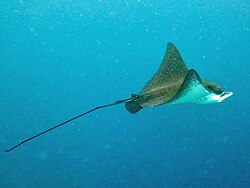| Aetobatus ocellatus | |
|---|---|
 | |
| Aetobatus ocellatus in the Maldives | |
| Scientific classification | |
| Kingdom: | Animalia |
| Phylum: | Chordata |
| Class: | Chondrichthyes |
| Subclass: | Elasmobranchii |
| Order: | Myliobatiformes |
| Family: | Aetobatidae |
| Genus: | Aetobatus |
| Species: | A. ocellatus |
| Binomial name | |
| Aetobatus ocellatus (Kuhl, 1823) | |
The ocellated eagle ray or the whitespotted eagle ray, Aetobatus ocellatus, is a species of cartilaginous fish in the eagle ray family Myliobatidae. It is found in the tropical Indo-West Pacific region. [2] [3] In the past it was included in the spotted eagle ray (A. narinari), a species restricted to the Atlantic after the split. [4] [5] [6]
